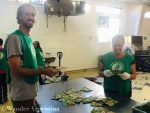 Argentine Spanish, or castellano, can be particularly confusing for those who’ve learned the language elsewhere and arrive to find themselves perplexed by the unique intonation, lunfardo (slang) and an endless amount of words and grammar that differ from those in other Spanish speaking countries.
Argentine Spanish, or castellano, can be particularly confusing for those who’ve learned the language elsewhere and arrive to find themselves perplexed by the unique intonation, lunfardo (slang) and an endless amount of words and grammar that differ from those in other Spanish speaking countries.
Confused foreigners who are wondering why the rules they learned at school no longer apply should check out the advice below.
Once you start to notice these cultural quirks, you’ll be on your way to speaking like a local.
*Note: these tips apply to the castellano in Buenos Aires and to a lesser extent the rest of Argentina — elsewhere, you’re on your own.
1. Common Greetings
The rules of which type of greeting to use are tricky but choosing the most natural greeting in any given situation can help one sound like a local off the bat. One heard often – ‘¿hola, qué tal?’ is basically, ‘hi, are you?’ although the question is usually rhetorical. A casual greeting, it’s the sort of thing you say when you walk into a shop or get into a taxi.
‘¿Comó andas?’ literally translates to ‘How’s it going?’. It is a more informal way to inquire about someone’s wellbeing. ‘¿Qué haces?,’ which in other parts of the world means, ‘What do you do?’ in Argentina means, ‘How are you doing?’ If you want to ask what someone does for a living, you should ask ‘¿A qué te dedicas?’ but beware that many Argentines consider this a slightly offensive ‘yuppie question.’
Other greetings are ‘¿Todo bien?’ literally, ‘Is everything good?’ or ‘¿Todo en orden’? – ‘Is everything in order?’ A common answer to this sort of question among the older generation is, ‘Todo bien, por suerte.’ This means everything’s good — thankfully — and implies that the world is likely about to crumble but gracias a Dios – thank God, we’re all okay. The implied expectation of doom at any moment is hardly surprising considering Argentina’s chaotic history.
2. Mimicking
The best way to learn is to listen to those around you and copy them. The next time you hear an Argentine exclaiming loudly, try and copy their intonation (assuming it’s not an angry tirade). Repeat what they say under your breath and copy it as if you were trying to remember a phone number or a piece of music. This ties in nicely to the next point:
3. Diminutives, Augmentatives and Emphasis
Argentines often put words in the diminutive form, instead of ‘¡Qué perro lindo!’ – ‘What a pretty dog!’ it becomes, ‘¡Qué perrito lindo!’ -‘What a pretty little dog!’ ‘Estoy buscando un papel’ – I’’m looking for a piece of paper,’ turns into ‘Estoy buscando un papelito’ – a little piece of paper. The paper is of course, normal size. The dog, may indeed be a miniature that looks like a cat or a small weasel.
At the other end of the scale augmentatives like ísimo add emphasis to adjectives that end in ‘o’ malo becomes malísimo, (really bad) and something is not just bueno but buenísimo (really good). Aso, means big and adds emphasis to nouns, so tema – song becomes temaso (literally ‘big song’ although it actually means ‘great tune’).
Putting ‘eh’ on the end of sentences is a local habit used to stress your point. Instead of ‘es buenísimo’ or ‘qué bueno’ you could say, ‘Qué bueno, ¿eh?’ Once you start to notice the ‘eh’ you’ll hear it popping up all over the place. Older ladies use it all the time when chatting with local vendors, they often say ¡Muy amable eh! (You’re very kind) or ¡Gracias eh! (Many thanks!) as they leave the shop.
The ‘Qué + adjective’ structure is useful in many situations. ‘¡Qué calor!’ – It’s so hot! ‘¡Qué hambre!’– What hunger! Or ‘¡Qué sueño!’ – What sleepiness! The last one is particularly useful when you’ve been dragged out until 6 a.m. and are wondering how the locals manage to get up for work the next day.
4. Gesticulation
A surefire way to look like a porteño is to gesticulate wildly while you talk. The Italian roots of many Argentines mean that hand gestures are as important as the words themselves. A common gesture is the use of the index right finger under the same eye pulling the skin of the eye down slightly. Usually accompanied by ‘¡Ojo eh!’ This can mean ‘Watch out!’ or can also signify ‘Hey! Take note of this!’
If you want to say ‘¿Qué me importa?’ — ‘I don’t care’ a shrug of the shoulders will get the point across, but it’s not as Argentine nor as fun as placing your bent fingers under your chin before moving them away dramatically.

There are plenty of other uniquely Argentine hand movements — watch out for hands flailing in eccentric ways and pay close attention to the context.
5. Facial expressions
When stuck lined up for the bus, bank, to pay a bill or negotiate some other kind of tramite —a job that takes ages, it’s a good idea to exchange sympathetic, exasperated looks with the person next to you — just a roll of the eyes or a shake of the head is enough.
If worst comes to worst and you have no idea what’s going on in a conversation in which you are supposedly participating, simply smile and nod. Usually you can pick up clues of what people are saying to you by the context and gestures. If everyone else is laughing, laugh along, and just hope they don’t then ask you, ‘¿Entendés?’ – ‘Do you understand?’ An over-explained joke is never funny and it’s even worse when you get the joke but don’t understand why everyone else is laughing.
—Interaction and Language Practice
By practicing these tips you’ll eventually start to sound like a local. Tirando un lujo – throwing out something that will impress, such as a colloquial phrase or gesture is sure to get a laugh, even if your Spanish is awful.
Whether or not you are convincing depends entirely on the ease in which you do things. Argentines tend to look as cool and collected as possible, except of course when they’re arguing or being emotional — it’s at that point that they get very worked up and flail their hands about even more than usual.
Overall, just go with the flow, learn local greetings, mimic the intonation, exaggerate and gesticulate, as you simultaneously roll your eyes, smile and nod. Who said language learning was difficult?
— Rosie Hilder


[…] Click here to continue reading Categories: Published Work […]